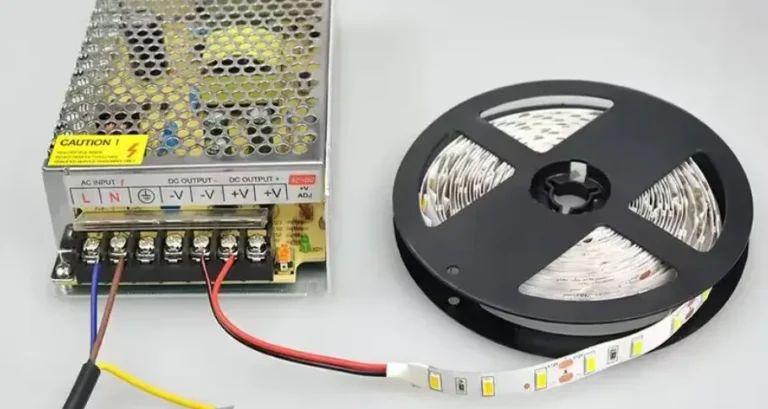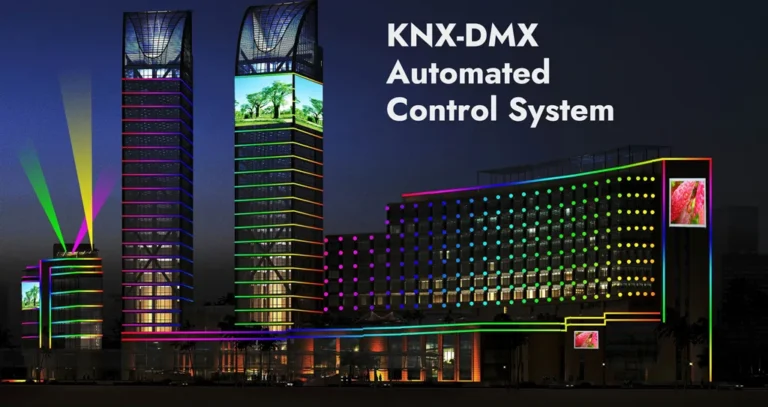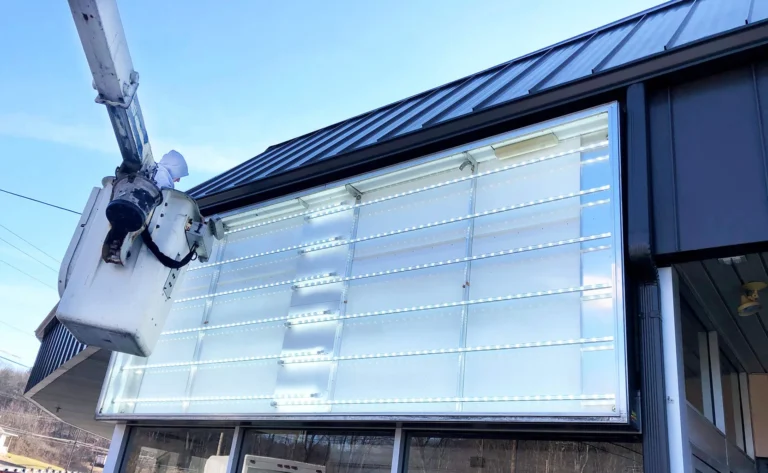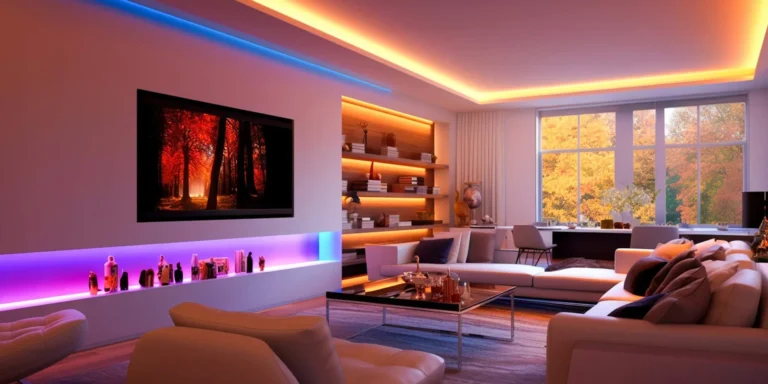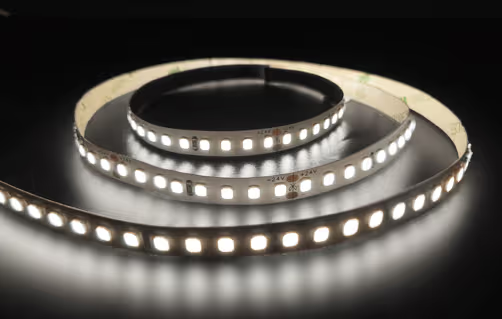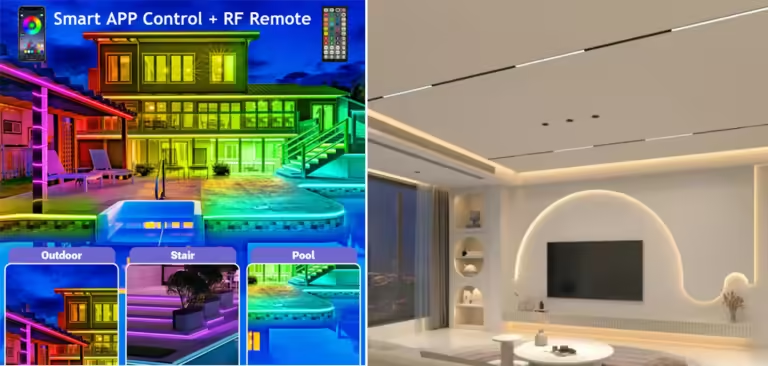Wyobraź sobie, że wchodzisz do biura lub centrum handlowego i czujesz się od razu komfortowo – dzięki antyoślepiającym, niskim światełkom LED UGR – nie mrużąc ostrym światłem, nie rozpraszając się rażącymi odbiciami.
W dzisiejszych przestrzeniach komercyjnych oświetlenie nie dotyczy już tylko jasności. Dzięki oświetleniu LED Low UGR (UGR ≤ 19), odblaski są zminimalizowane, a oczy są szczęśliwsze – niezależnie od tego, czy pracujesz nad raportem, przeglądasz produkty, czy uczestniczysz w wykładzie. Chodzi o stworzenie środowiska, w którym ludzie mogą się skupić, robić zakupy lub uczyć się bez zmęczenia wizualnego.
Światła te są starannie zaprojektowane z inteligentnymi komponentami optycznymi – takimi jak dyfuzory, soczewki i żaluzje o strukturze plastra miodu – aby zapewnić równomierne rozłożenie światła bez ostrych szczytów. Wynik? Komfortowe środowisko oświetlenia, które zwiększa produktywność, poprawia wrażenia klientów i podnosi ogólną estetykę przestrzeni.
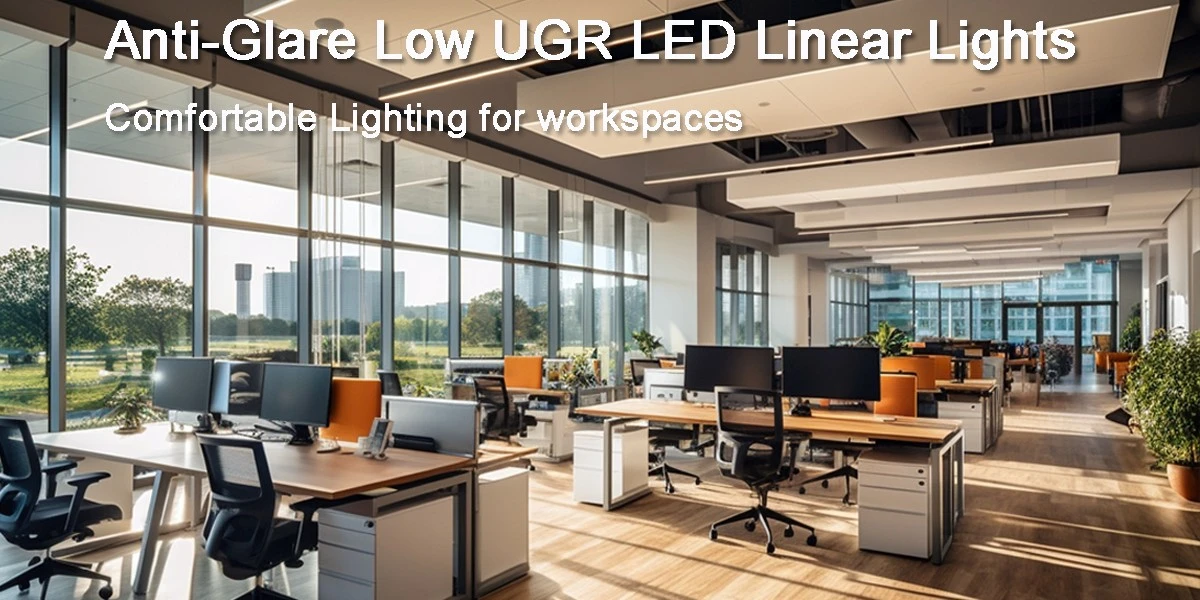
Co to jest UGR i dlaczego ma znaczenie w projektowaniu oświetlenia?
Co to jest UGR?
Unified Glare Rating (UGR) to znormalizowana metryka opracowana przez CIE (Międzynarodowa Komisja ds. Oświetlenia) w celu ilościowego określenia dyskomfortu wizualnego spowodowanego olśnieniem w środowiskach oświetlenia wewnętrznego. UGR podaje wartość liczbową, która wskazuje, jak prawdopodobne jest, że źródło światła spowoduje dyskomfort podczas oglądania z typowej pozycji siedzącej.
Wartości UGR wahają się od 5 (bardzo niskie olśnienie) do 40 (bardzo wysokie olśnienie). W przypadku przestrzeni komercyjnych, takich jak biura, szkoły i środowiska handlowe, ogólnie zaleca się utrzymanie UGR poniżej 19 lat, aby zapewnić komfortowe wrażenia wizualne.
Odniesienie do oceny UGR
| Wartość UGR | Poziom komfortu | instrukcja |
| 10–19 | Dobry | Odblask jest dopuszczalny w większości obszarów roboczych |
| 20–22 | do przyjęcia | Blask może być zauważalny, ale nie nadmiernie niepokojący |
| 22–25 | pogranicze | Blask może być nieprzyjemny |
| >25 | gorszący | Blask jest bardzo nieprzyjemny |

Jak obliczane jest UGR?
UGR nie jest stałą własnością oprawy, ale zależy od instalacji oświetleniowej jako całości. Czynniki wpływające na UGR obejmują:
luminancja źródeł światła
- Luminacja tła
- Pozycja obserwatora i kąt widzenia
- Geometria pomieszczenia
- Odbicie powierzchni
- Układ oprawy (rozstaw, wysokość, orientacja)
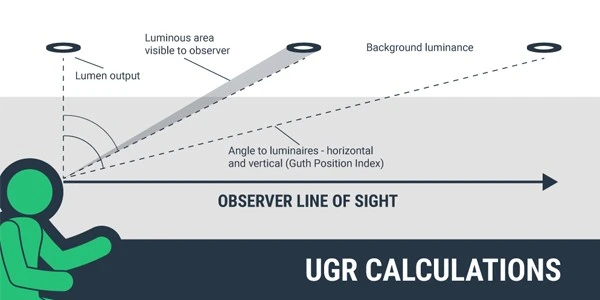
W praktyce do symulacji tych parametrów i obliczania wartości UGR powszechnie używane jest oprogramowanie takie jak DIALUX, Relux lub AGI32. Zgodnie z metodą TRILUX „Metoda tabeli UGR” standardowe rozmiary pomieszczeń, wartości współczynnika odbicia powierzchni i pozycje obserwatora są stosowane, aby wyniki były porównywalne dla różnych produktów.
Znormalizowane rozmieszczenie obserwatora i poziomej płaszczyzny oprawy, umieszczone w H = H – P – 1,2 (w metrach) powyżej poziomu oczu obserwatora dla pozycji siedzących, gdzie P oznacza długość zawieszenia oprawy oprawy.
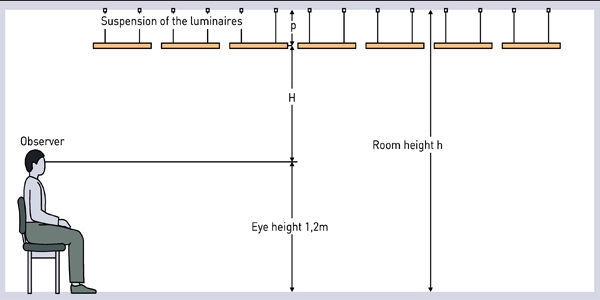
W przypadku wąskich układów opraw (s = 0,25 h) wartość UGR pozostaje prawie niezależna od pozycji oglądania obserwatora.
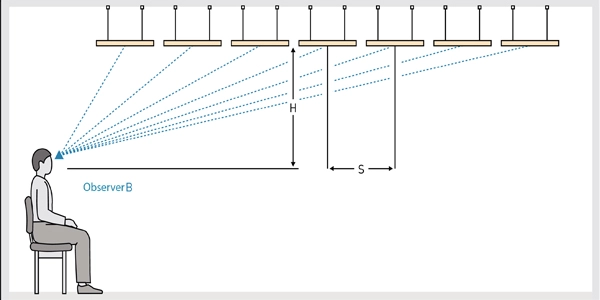
Przy szerszym rozstawie opraw obserwator B1 doświadcza niższego UGR, podczas gdy obserwator B2 widzi wyższy UGR. Jednak obie wartości na ogół pozostają poniżej poziomu UGR obserwowanego w układzie wąskich opraw.
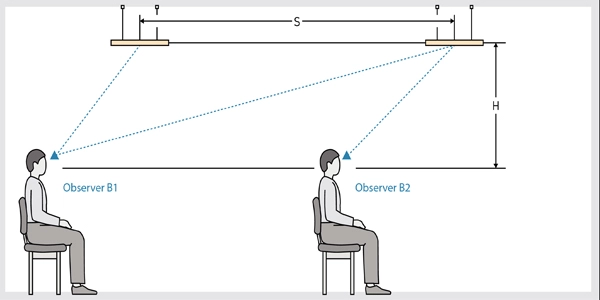
Uwaga: Zgodnie z EN 12464-1 tabele UGR mogą być również oparte na odległościach opraw oświetleniowych większych niż S = 0,25 h. Na przykład w Wielkiej Brytanii powszechnie stosuje się S = 1,0 h, co skutkuje niższymi wartościami UGR i większą wydajnością opraw oświetleniowych. Wymaga to jednak od projektantów dokładnego sprawdzenia pozycji obserwatora, aby uniknąć większego olśnienia pod pewnymi kątami widzenia.
Dlaczego UGR ma znaczenie?
Zwiększenie komfortu wizualnego
Low UGR Lighting zmniejsza bezpośrednie odblaski i hotspoty, minimalizując zmęczenie oczu podczas długotrwałych czynności, takich jak praca na komputerze, czytanie lub uczęszczanie na zajęcia.
Wsparcie produktyw
Dobrze kontrolowane odblaski poprawiają koncentrację i wydajność. Badania pokazują, że pracownicy lub studenci w środowiskach o niskim blasku dłużej się skupiają i odczuwają mniejsze zmęczenie.
Tworzenie profesjonalnej i zachęcającej atmosfery
W sklepach detalicznych lub hotelarskich oświetlenie o niskim blasku zapewnia, że produkty, wyświetlacze i elementy architektoniczne są wyraźnie widoczne bez dyskomfortu, poprawiając wrażenia klientów.
Osiąganie celów UGR
Producenci często określają produkty jako „UGR<19”, ale nie gwarantuje to, że samo światło osiąga ocenę. Zamiast tego wskazuje, że konstrukcja optyczna oprawy (np. dyfuzory, żaluzje, soczewki) wspiera osiągnięcie celu, gdy jest odpowiednio zainstalowane w odpowiednim środowisku.
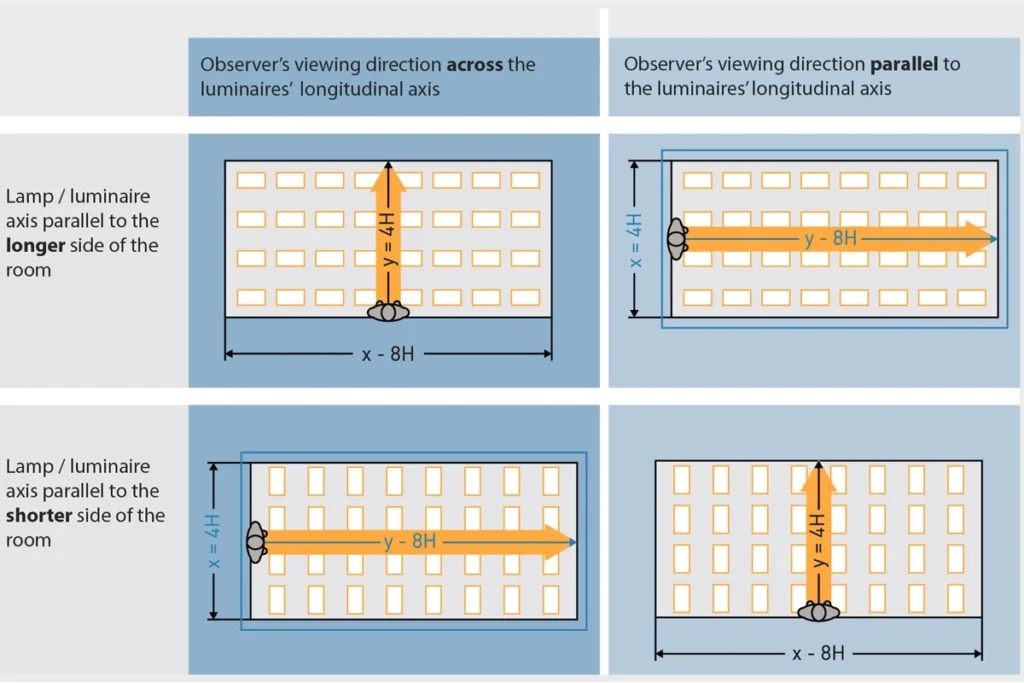
Kierunek widzenia obserwatora jest pokazany w poprzek (po lewej) i równolegle (prawo) do osi oprawy, która może być wyrównana z dłuższą (górą) lub krótszą (na dole) stroną pomieszczenia. współrzędne x (na w polu) i y (Parallel) Wskaż przykładowe pozycje, podświetlone na niebiesko i czerń dla przejrzystości.
Cechy światła liniowego LED Anti-Glare Low UGR LED
Oświetlenie liniowe LED Low UGR zostało zaprojektowane tak, aby zmniejszyć dyskomfort wizualny i stworzyć komfortowe przestrzenie komercyjne. Ich wydajność zależy nie tylko od chipów LED, ale także komponentów optycznych, konstrukcji obudowy i precyzyjnego rozsyłu światła.
Komponenty optyczne
dyfuzor
Cel: równomiernie rozprowadza światło, redukuje gorące punkty i zmiękcza odblaski. : : : : Równomiernie rozprowadza światło, redukuje gorące punkty i zmiękcza odblaski.
rodzajowość: Mikrostrukturalne dyfuzory PMMA/PC, matowe lub matowe powierzchnie.
obiektyw
Cel: Kontroluje kąt wiązki, zapewniając, że światło jest kierowane do przestrzeni roboczej, unikając bezpośredniego oślepiania oczu.
rodzajowość: Soczewki liniowe, soczewki PC klasy optycznej.
żaluzja
Cel: Osłona bezpośrednie światło z linii wzroku, minimalizując odblaski przy jednoczesnym zachowaniu jasności na powierzchniach roboczych.
Materiał i projekt: aluminium lub plastik; rozmiar komórki, głębokość i odstępy bezpośrednio wpływają na UGR.
odbicie
Cel: Optymalizuje rozkład światła, redukuje strefy o wysokiej luminancji i zapobiega bezpośredniemu olśnieniu.
Materiał: Powierzchnie z aluminium lub powlekane o wysokiej refleksji.
Chip LED i obudowa
Układ o wysokiej rozdzielczości CRI
Zapewnia naturalne oddawanie kolorów (CRI>80 lub 90), zmniejsza zmęczenie wzroku i działa synergistycznie z komponentami optycznymi, aby zwiększyć komfort.
Projekt obudowy
Głębokie lub ekranowane konstrukcje krawędzi zmniejszają bezpośrednią jasność widoczną przez pasażerów. Głębokość doliny światła i geometria oprawy odgrywają kluczową rolę w obniżaniu UGR.
Integracja i dystrybucja światła
Połączenie powyższych komponentów umożliwia precyzyjną kontrolę kierunku i intensywności światła, zapewniając równomierne oświetlenie powierzchni roboczych przy zachowaniu niskiej wartości UGR.
Projektanci mogą osiągnąć UGR<19 w typowych instalacjach biurowych, edukacyjnych lub detalicznych poprzez staranny dobór dyfuzorów, soczewek i geometrii obudowy.
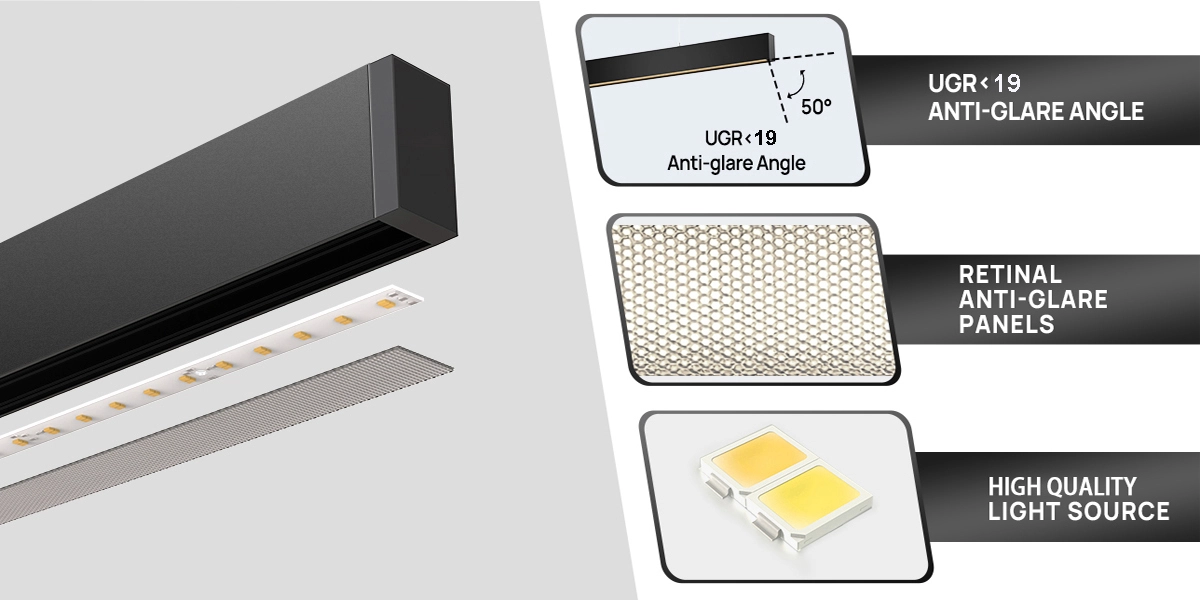
Zastosowania światła liniowego LED Low UGR LED
Lampy liniowe LED Low UGR są szeroko stosowane w nowoczesnych przestrzeniach komercyjnych i instytucjonalnych, w których komfort wizualny jest priorytetem. Minimalizują odblaski, pomagają stworzyć produktywne, przyjazne i estetyczne otoczenie.
Oświetlenie biurowe
W biurach na otwartym planie, salach konferencyjnych i przestrzeniach coworkingowych oświetlenie bez olśnienia zmniejsza zmęczenie oczu i zapewnia długie godziny pracy komputerowej. Utrzymanie UGR<19 jest często wymogiem projektowym w środowiskach korporacyjnych, aby spełnić międzynarodowe standardy oświetlenia (np. EN12464).
Handel handlowo-handlowy
Powierzchnie handlowe czerpią korzyści z niskiego oświetlenia UGR, ponieważ zapewnia czystą widoczność produktu bez powodowania dyskomfortu dla kupujących. Liniowe światła z dyfuzorami przeciwoślepiającymi lub żaluzjami poprawiają wyświetlacz towarów, jednocześnie zapewniając komfort zakupów i zachęcające do zakupów.
Instytucje edukacyjne
Sale lekcyjne, biblioteki i sale wykładowe wymagają oświetlenia, które wspiera koncentrację i zmniejsza zmęczenie wizualne. Linearowe światła LED Low UGR pomagają uczniom i nauczycielom pozostać skupionym, tworząc optymalne środowisko do nauki i czytania.
Gościnność i przestrzenie publiczne
W hotelach, lobby, restauracjach i publicznych poczekalniach oświetlenie musi równoważyć komfort i estetykę. Oprawy liniowe o niskim UGR zapobiegają dyskomfortowi gościom, jednocześnie poprawiając detale architektoniczne, oznakowanie i atmosferę wnętrza.
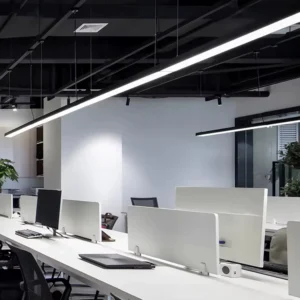
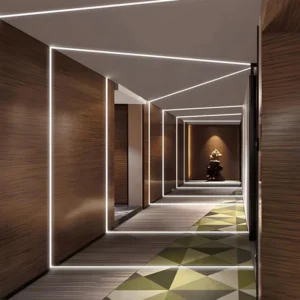
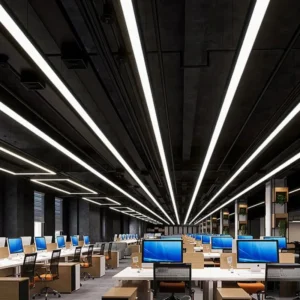
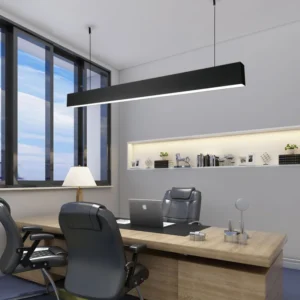
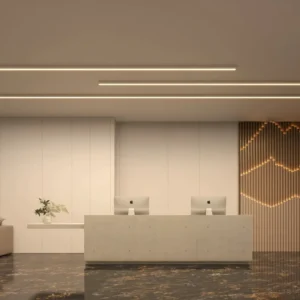
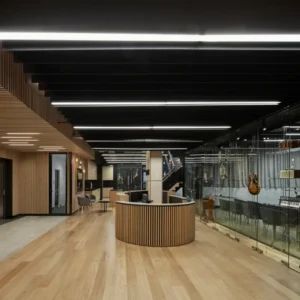
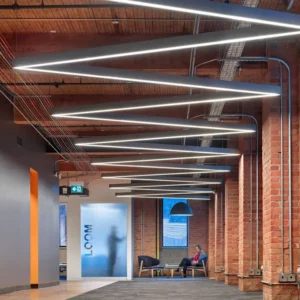

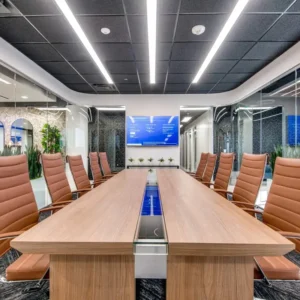
Porównanie: niskie światło liniowe UGR a oświetlenie konwencjonalne
Oceniając oświetlenie dla przestrzeni komercyjnych, ważne jest porównanie świateł liniowych LED Low UGR z konwencjonalnymi oprawami, takimi jak standardowe lampy fluorescencyjne, podstawowe panele LED lub niezoptymalizowane światła liniowe. Różnice podkreślają, dlaczego kontrola olśnienia jest niezbędna w nowoczesnym oświetleniu.
Komfort wizualny
- LINIA LINII LINII UGR: Zaprojektowany z dyfuzorami, żaluzjami lub odblaskami w celu zmniejszenia odblaski, tworząc miękkie i zrównoważone oświetlenie, które minimalizuje zmęczenie oczu.
- Konwencjonalne oświetlenie: często powoduje bezpośrednie odblaski lub widoczne jasne punkty, zwłaszcza z gołych rur lub paneli niskiej jakości, co prowadzi do dyskomfortu podczas długiej ekspozycji.
Zgodność ze standardami
- Light liniowe LOW UGR: spełnia wymagania norm EN12464, standardowe budowanie i wytyczne LEED, zwłaszcza kryterium UGR<19 w biurach i salach lekcyjnych.
- Konwencjonalne oświetlenie: może nie spełniać nowoczesnych wymagań odblaskowych, co nie nadaje się do projektów, w których ważna jest certyfikacja i komfort wizualny.
Produktywność i doświadczenie użytkownika
- LINIA LINIA LINII UGR: Zwiększa ostrość, zmniejsza zmęczenie i tworzy przyjemną atmosferę, bezpośrednio wspierając wyższą produktywność i satysfakcję klientów.
- Konwencjonalne oświetlenie: może powodować dyskomfort oczu, bóle głowy i zmniejszoną koncentrację, co negatywnie wpływa na wydajność pracy i wrażenia użytkownika.
Estetyka i integracja architektoniczna
- LINIA LINII LINII UGR: Oferuje eleganckie wzory, jednolitą moc światła i minimalny blask, poprawiając estetykę architektoniczną nowoczesnych biur, powierzchni handlowych i hotelarskich.
- Konwencjonalne oświetlenie: przestarzałe projekty lub niekontrolowany rozkład światła mogą zakłócić estetykę wnętrza i stworzyć nierównomierne oświetlenie.
Tabela podsumowująca
| Aspekt | LINIA LINIA LINII UGR | Konwencjonalne oświetlenie |
| Kontrola olśnienia | UGR<19, wygodny | często >22, zauważalne lub szorstkie |
| standardy | Spotyka EN12464, no, Leed | Wymagania mogą się nie powieść |
| Komfort wizualny | Miękki, zrównoważony, przyjazny dla oka | Surowe, powoduje obciążenie |
| produkcyjność | Poprawia koncentrację i dobre samopoczucie | Zmniejsza ostrość, może powodować zmęczenie |
| Estetyka | Nowoczesne, czyste, architektoniczne dopasowanie | Nierówne światło, przestarzały wygląd |
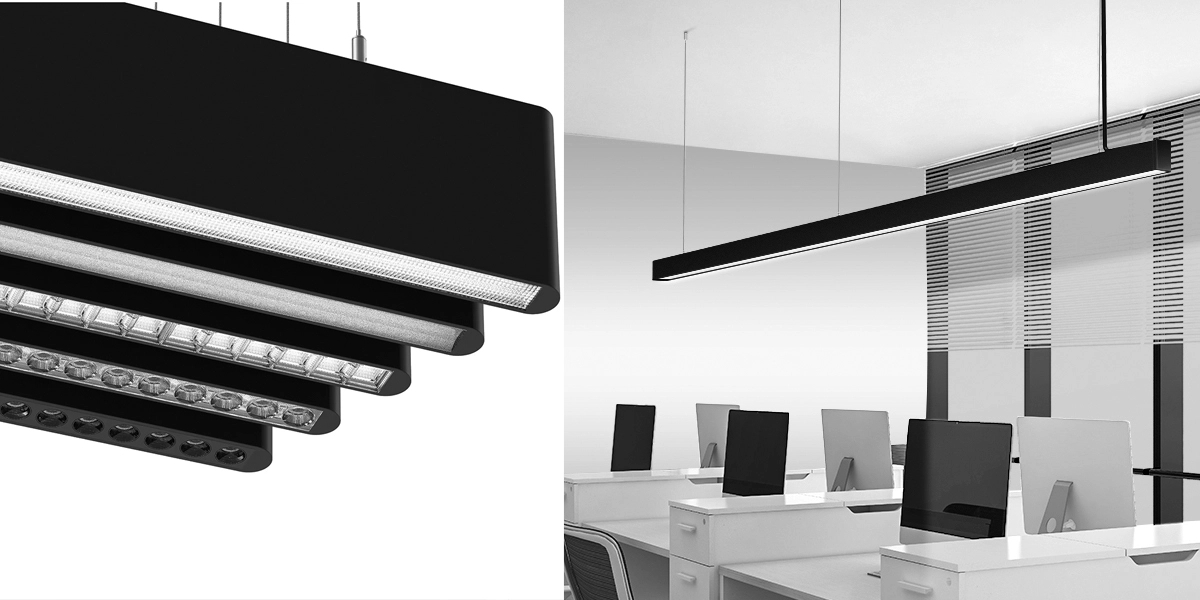
Rozmiar profilu: W25 * H85mm
Długość opcjonalna: 1200/1500/1800/2400 mm
Temperatura barwowa (CCT): 3000K/4000K/6000K/CCT
Wydajność lampy (lm/W): 100 lm/W
Moc: 40W/50W/60W/80W
Indeks oddawania kolorów (Ra): >80, >90
Typ źródła światła: LED SMD2835
Dostępne ściemnianie: bez przyciemnienia/ 0-10V/ ściemnianie DALI
Główny materiał: Aluminium + PC / PMMA / Dyfuzor pryzmatyczny
Kolor powłoki: czarny/biały/srebrny
Instalacja: zawieszona/powierzchniowa/ścienna/ścienna
Jak wybrać odpowiednie liniowe światło liniowe LED LOW UGR i listę kontrolną kupującego?
Wybierając oświetlenie liniowe przeciwodblaskowe do biur, szkół, projektów handlowych lub hotelarskich, nie wystarczy przeglądać arkusze danych produktów. Kupujący powinni sprawdzić, czy oprawy rzeczywiście spełniają wymagania dotyczące wydajności i zgodności. Poniższe wytyczne zamieniają funkcje techniczne w praktyczne kontrole zamówień.
Zweryfikuj raporty testów UGR
- Poproś o oficjalne dane testowe UGR od dostawcy, a nie tylko oświadczenia marketingowe.
- Potwierdź, że wartości są testowane w warunkach EN 12464-1 (np. UGR ≤19 dla biur/sale klas).
Poproś o próbki do oceny na miejscu
- Sprawdź kontrolę odblasków, jednolitość światła i komfort w prawdziwym środowisku projektowym.
- Umieść oprawy na zamierzonych wysokościach montażowych, aby zasymulować efekt końcowy.
Potwierdź certyfikację i z
- Poszukaj zgodności CE, ROHS, UL i EN 12464-1.
- Certyfikacja zapewnia bezpieczeństwo, jakość i przydatność do przetargów międzynarodowych.
Oceń elastyczność projektu
- Czy producent oferuje niestandardowe długości, przestrajalny CCT lub inteligentne sterowanie (DALI/DMX)?
- Elastyczność zapewnia, że oświetlenie może dostosować się do zmieniających się wymagań projektowych.
Sprawdź gwarancję i wsparcie po sprzedaży
- Zalecana jest minimum 3-5 lat gwarancji.
- Niezawodna obsługa posprzedażowa zmniejsza ryzyko w projektach długoterminowych.
Lista kontrolna kupującego
| Kryteria | Co zweryfikować |
| Ocena UGR | Złóż wniosek o sprawdzenie, biura/klasy ≤19, Przemysł ≤16 |
| Przykładowa ocena | Sprawdź kontrolę olśnienia, jednolitość, komfort w prawdziwej przestrzeni |
| Certyfikacja | EN 12464-1, CE, ROHS, UL lub lokalne aprobaty |
| Elastyczność | Niestandardowe długości, przestrajalne opcje CCT, DALI/DMX |
| Gwarancja i serwis | 3-5 lat gwarancji, niezawodne wsparcie posprzedażowe |
Wniosek
Oświetlenie liniowe LED Low UGR stanowi znaczny postęp w oświetleniu komercyjnym i instytucjonalnym, oferując zrównoważone połączenie komfortu wizualnego, efektywności energetycznej i elastyczności projektowania. Rozumiejąc koncepcję UGR i wybierając oprawy z dobrze zaprojektowanymi komponentami optycznymi, kupujący mogą tworzyć środowiska, które zmniejszają odblaski, zwiększają produktywność i zapewniają przyjemne wrażenia dla pasażerów. Od biur i sal lekcyjnych po powierzchnie handlowe i środowiska hotelowe, oświetlenie niskiego UGR jest coraz częściej uznawane za standard dla nowoczesnego, zorientowanego na człowieka oświetlenia.
